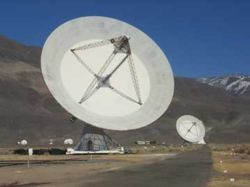Owens Valley Radio Observatory: Difference between revisions
imported>Mary Ash No edit summary |
mNo edit summary |
||
| (4 intermediate revisions by one other user not shown) | |||
| Line 1: | Line 1: | ||
{{subpages}} | {{subpages}} | ||
{{TOC|right}} | {{TOC|right}} | ||
The '''Owens Valley Radio Observatory''' is operated by the California Institute of Technology. The observatory is located in the Owens Valley and is 14 miles south of Bishop, California, USA. Access to the radio observatory is from Big Pine. | {{Image|OVSA2.jpg|left|250px|Owens Valley Radio Observatory 27 meter antenna.}} | ||
The '''Owens Valley Radio Observatory''' is operated by the [[California Institute of Technology]]. The observatory is located in the [[Owens Valley]] and is 14 miles south of [[Bishop, California]], USA. Access to the radio observatory is from[[ Big Pine]], California, USA. | |||
The Owens Valley Solar Array (OVSA) is the only solar dedicated radio observatory in the US. The array consists of two 27-meter antennas together with five 2-meter dishes which observe the Sun The Solar Array is operated by the New Jersey Institute of Technology. | The Owens Valley Solar Array (OVSA) is the only solar dedicated [[radio observatory]] in the US. The array consists of two 27-meter antennas together with five 2-meter dishes which observe the Sun The Solar Array is operated by the New Jersey Institute of Technology. | ||
A | A 40 meter telescope is located at the observatory along with a 6.1 meter telescope donated by the[[ Jet Propulsion Laboratory]] (JPL). | ||
Owens Valley Radio Observatory personnel also help operate[[ Combined Array for Research in Millimeter-wave Astronomy]] (CARMA), located in the [[Inyo Mountains]]. This is a collaborative effort between Caltech, [[University of California]] Berkeley, [[University of Illinois]], [[University of Maryland]], and the [[University of Chicago]]. Researchers are using a 23-element interferometer that observes at centimeter and millimeter wavelengths. | |||
== History == | == History == | ||
The first telescope was built in 1958 and was originally located in Palomar, California, USA. The 32-foot telescope was moved to the Owens Valley Radio Observatory in 1958. John Bolton and Gordon Stanley designed this telescope. | The first telescope was built in 1958 and was originally located in [[Palomar, California]], USA. The 32-foot telescope was moved to the Owens Valley Radio Observatory in 1958. John Bolton and Gordon Stanley designed this telescope. | ||
Construction of the first | Construction of the first interferometer was done during the 1950s. By [[Christmas]] Day in 1959 the first arm of the interferometer opened. The following year the second arm of the interferometer was in operation. | ||
Construction of a six-element millimeter array consisting of six 10-meter dishes was done. The array is located at Cedar Flat and is part of CARMA. | Construction of a six-element millimeter array consisting of six 10-meter dishes was done. The array is located at Cedar Flat and is part of CARMA. | ||
| Line 24: | Line 26: | ||
}}</ref> | }}</ref> | ||
==References== | ==References== | ||
{{reflist|2}} | {{reflist|2}}[[Category:Suggestion Bot Tag]] | ||
Latest revision as of 11:00, 30 September 2024
The Owens Valley Radio Observatory is operated by the California Institute of Technology. The observatory is located in the Owens Valley and is 14 miles south of Bishop, California, USA. Access to the radio observatory is fromBig Pine, California, USA.
The Owens Valley Solar Array (OVSA) is the only solar dedicated radio observatory in the US. The array consists of two 27-meter antennas together with five 2-meter dishes which observe the Sun The Solar Array is operated by the New Jersey Institute of Technology.
A 40 meter telescope is located at the observatory along with a 6.1 meter telescope donated by theJet Propulsion Laboratory (JPL).
Owens Valley Radio Observatory personnel also help operateCombined Array for Research in Millimeter-wave Astronomy (CARMA), located in the Inyo Mountains. This is a collaborative effort between Caltech, University of California Berkeley, University of Illinois, University of Maryland, and the University of Chicago. Researchers are using a 23-element interferometer that observes at centimeter and millimeter wavelengths.
History
The first telescope was built in 1958 and was originally located in Palomar, California, USA. The 32-foot telescope was moved to the Owens Valley Radio Observatory in 1958. John Bolton and Gordon Stanley designed this telescope.
Construction of the first interferometer was done during the 1950s. By Christmas Day in 1959 the first arm of the interferometer opened. The following year the second arm of the interferometer was in operation.
Construction of a six-element millimeter array consisting of six 10-meter dishes was done. The array is located at Cedar Flat and is part of CARMA.
Tours
CARMA tours are offered May through October while OVRO tours are offered November through April. Call ahead for group tours. Call 760.938.2075 ext. 109 to arrange a group tour.[1]
References
- ↑ Owens Valley Radio Observatory, California Institute of Technology. Retrieved on 2011-02-01.
